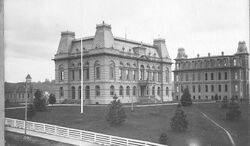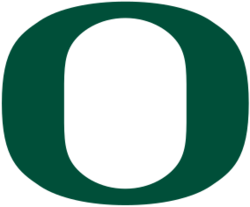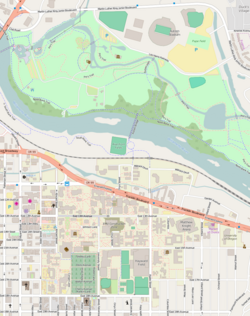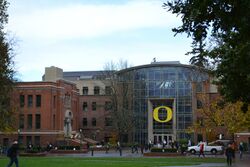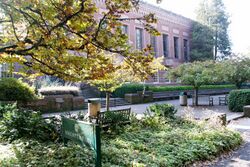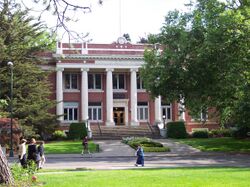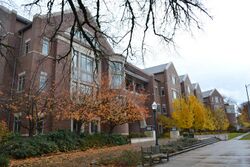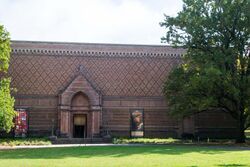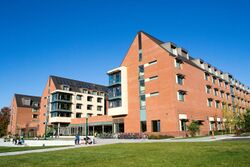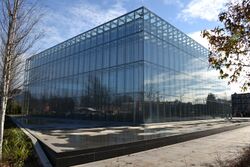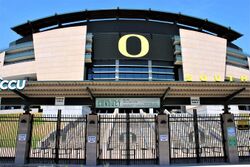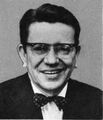Organization:University of Oregon
 | |
| Latin: Universitas Oregonensis | |
Former names | Oregon State University (1876–1877)[1] |
|---|---|
| Motto | Mens agitat molem (Latin) |
Motto in English | "The Mind Moves Mountains" / (lit.) "Mind moves the mass" |
| Type | Public research university |
| Established | October 12, 1872 (established) October 16, 1876 (opened) |
Academic affiliations |
|
| Endowment | $1.4 billion (2022)[2] |
| Budget | $1.05 billion (2017)[3] |
| President | Karl Scholz[4] |
| Students | 23,202[5] |
| Location | Eugene , Oregon , United States [ ⚑ ] : 44°02′39″N 123°04′33″W / 44.0443°N 123.0758°W |
| Campus | Midsize city[6] |
| Other campuses | |
| Newspaper | Daily Emerald |
| |u}}rs | Script error: No such module "College color". |
| Nickname | Ducks |
Sporting affiliations |
|
| Mascot | The Oregon Duck |
| Website | www |
 | |
The University of Oregon (UO, U of O or Oregon) is a public research university in Eugene, Oregon. Founded in 1876,[7] the university also has two Portland locations, and manages a marine station, called the Oregon Institute of Marine Biology, in Charleston; and an observatory, called Pine Mountain Observatory, in Central Oregon.
The University of Oregon is organized into nine colleges and schools[8] and offers 316 undergraduate and graduate degree programs.[9] Most academic programs follow the 10 week Quarter System.[10] The university is classified among "R1: Doctoral Universities – Very high research activity" and is a member of the Association of American Universities.[11][12] Since July 2014, UO has been governed by its own board of trustees.
UO's 295-acre campus is situated along the Willamette River.[13] UO student athletes compete as the Ducks and are part of the Pac-12 Conference in the National Collegiate Athletic Association (NCAA). With eighteen varsity teams, the Oregon Ducks are best known for their football team and track and field program.[14][15][16][17] These two teams are even incorporated into the design of the school's "O" logo.[18] In the summer of 2022, UO hosted the 2022 World Athletics Championships. It was the first time the event was held in the United States.[19] UO's colors are green and yellow.[20]
The university has a long and complex relationship with Nike, Inc., and the firm's co-founder Phil Knight.[21][22] As a consequence of state higher-education disinvestment starting in the 1990s, UO has embraced a "University of Nike" image.[22] Fueled by large investments in athletic infrastructure, this trend has accelerated in recent years. Knight, an alumnus, has advocated for both athletic prominence and increased privatisation of the university, and has donated over $1 billion to UO since the late-1980s, much of it going towards athletics.[23][24][25][26][27] The school's "O" logo was designed by Nike in 1998 and sports facility projects on campus typically involve both Knight and Nike.[18][28][21]
History
The land
The University of Oregon is located on Kalapuya ilihi, the traditional indigenous homeland of the Kalapuya people. Following treaties between 1851 and 1855, Kalapuya people were dispossessed of their indigenous homeland by the United States government and forcibly removed to the Coast Indian Reservation in Western Oregon. Today, Kalapuya descendants are primarily citizens of the Confederated Tribes of Grand Ronde and the Confederated Tribes of Siletz Indians.[29]
Motto
The university's motto, mens agitat molem translates from Latin as "mind moves mass", or poetically as "minds move mountains." The line comes from the Aeneid by Virgil, Book VI, line 727.[30]
The motto is now shared with the Eindhoven University of Technology, the Military Academy of the German Armed Forces, and the University of Warwick.
Early years
The Oregon State Legislature established the university in 1872 and named it Oregon State University.[31] The residents of Eugene raised $27,500 to buy eighteen acres of land at a cost of $2,500.[32] The doors opened in 1876 with the name of "Oregon State University" and University Hall as its sole building.[33] The first year of enrollment contained 155 students taught by five faculty members. The first graduating class was in 1878, graduating five students.[31] In 1881, the university was nearly closed; it was $8,000 in debt before Henry Villard donated $7,000 to help pay it.[31] In 1913 and 1932, there were proposals to merge the university with what is now Oregon State University. Both proposals were defeated.[9][34]
Maturity as a university
During Prince Lucien Campbell's tenure as president from 1902 to 1925, the university experienced tremendous growth. The budget, enrollment, facilities, and faculty members all grew several times its amount prior to his presidency.[9] Numerous schools were also established during his tenure, including the School of Music in 1902, the School of Education in 1910, the School of Architecture, the College of Business in 1914, the School of Law in 1915, the School of Journalism in 1916, and the School of Health and Physical Education in 1920.[9] However, the University of Oregon lost its School of Engineering to Oregon Agricultural College, now known as Oregon State University.[9]
| Historical total enrollment | |||||||||||||||||||||||||||||||||
|---|---|---|---|---|---|---|---|---|---|---|---|---|---|---|---|---|---|---|---|---|---|---|---|---|---|---|---|---|---|---|---|---|---|
|
| ||||||||||||||||||||||||||||||||
| Note: Medical School enrollment transferred to OHSU circa 1980.
Enrollment numbers include both undergraduate and graduate students. Source: IR | |||||||||||||||||||||||||||||||||
In 1917, a "three term" (quarter system) calendar was adopted by the university faculty as a war-time measure.[35][36] This academic calendar has remained ever since then. However, it is now referred to as the Quarter System.
The Zorn-MacPherson Bill in 1932 proposed the University of Oregon and Oregon State College (now "University") merge. The bill lost in a landslide vote of over 6 to 1.[37] The University of Oregon Medical School was founded in 1887 in Portland and merged with Willamette University's program in 1913. However, in 1974 it became an independent institution known as Oregon Health Sciences University.[38]
The Institute of Molecular Biology was established at the university in 1959.[39]
UO served as the filming location for the 1978 cult classic National Lampoon's Animal House.[40][41]
Golden age
The 60s and 70s were somewhat of a golden age for the university. In 1964, the university ranked 25th nationally in National Science Foundation basic research grants, ahead of the University of Rochester, Northwestern University, the University of Colorado and the University of Pittsburgh.[42]
In 1969, the UO was admitted into the Association of American Universities, along with Case Western Reserve University, the University of Maryland, and the University of Southern California.[12]
Graduate enrollment peaked during the 1978-79 academic year at 4,568.[43] From 1970 to 1979, 2,614 doctoral degrees were awarded at UO cumulatively.[44]
From 1970 to 1979, 817 UO undergraduate students would go on to earn doctoral degrees at UO or another institution. Despite increases in total undergraduate enrollment since the 60s and 70s, fewer UO undergraduate students would go on to earn doctorates in the 80s, 90s, 2000s and 2010s.[44]
| Decade | Average total enrolment | Average undergraduate enrolment[43] | Average graduate enrolment[43] | Doctoral degrees awarded[44] | UO undergraduates who earned doctorate in USA[44] |
|---|---|---|---|---|---|
| 1960s | 12,804 | 1,203 | 372 | ||
| 1970s | 16,252 | 12,160 | 4,092 | 2,614 | 817 |
| 1980s | 16,830 | 12,849 | 3,981 | 1,889 | 612 |
| 1990s | 17,015 | 13,477 | 3,538 | 1,883 | 725 |
| 2000s | 20,232 | 16,343 | 3,889 | 1,528 | 710 |
| 2010s | 23,727 | 20,037 | 3,690 | 1,580 | 810 |
Prominent UO researchers of this era include Michael Posner, Frank Stahl, George Streisinger and Aaron Novick.[citation needed].
UO experienced state disinvestment in the 1980s during the tenure of president Paul Olum.[31] Further state disinvestment occurred during the 1990s and during the Great Recession.[45] Many programs have been scaled back or eliminated.
Recent history
In recent years UO's administration and Board of Trustees have approved hundreds of millions of dollars in construction projects. These facilities include Matthew Knight Arena, the Ford Alumni Center, the EMU renovation (student union building), and dormitories.[46] This has occurred in tandem with state budget reductions, tuition increases, and increases in out-of-state enrollment.[47]
In 2016, the university removed the name of Frederic Stanley Dunn, head of the Classics department in the 1920s and 30s, from the dormitory Dunn Hall, because of his leading role in the Ku Klux Klan.[48]
Declining state support
Measure 5 established limits on property taxes in Oregon. This impacted the state budget, and lead to budget and programmatic cuts at UO starting the 1990s.[49] The College of Human Performance and Development was closed. Furthermore, many of the school's primary and secondary teacher training programs were eliminated.[50] By 1997, more than 20 other programs were closed or significantly reduced in size.
UO has initiated three capital campaigns in the last 30 years.[51][52][53][54] The first campaign of this era was launched with a goal of $150 million. It ended up raising a total of $255.3 million between 1992 and 1998.[52]
With financial support from the state dwindling from 40% to 13% of the university budget,[51] in January 2001, University President Dave Frohnmayer began Campaign Oregon with the goal of raising $600 million by December 2008, the most ambitious philanthropic fundraising campaign in the state's history at the time.[55] With contributions exceeding $100 million from benefactors such as Phil Knight and Lorry I. Lokey, the campaign goal was exceeded by over $253 million.[51][56]
In the fall of 2014, the institution announced that it would attempt to raise $2 billion from donors. In the fall of 2018, the campaign revised its goal to $3 billion.[57] Substantial gifts were donated by Phil Knight and his wife. In October 2016, it was announced Phil Knight and his wife Penny will contribute $500 million to establish the Phil and Penny Knight Campus for Accelerating Scientific Impact. At the time it was the largest donation to a public research university.[58] Knight gave an additional $500 million to the Knight Campus in 2021.[27]
In 2022, Steve Ballmer made a large gift of $425 million to fund a new institute for children's behavioral health.[59][60]
Despite the recent influx in private gifts given by mega-donors, as of 2020, UO's state subsidy per resident student is one of the lowest in both the Association of American Universities and Pac-12 Conference.[45][61]
"University of Nike"
The school's "O" logo was officially adopted by the university as a whole in 2002. Designed by Nike, it was first adopted by the athletic program in late-1998. The inside of the logo is said to depict Hayward Field, the institution's track and field venue. The outside of the logo is said to represent Autzen Stadium, which is UO's football stadium.[28]
Phil Knight has financed hundreds of millions of dollars worth of construction projects on UO's campus going back to the late-1980s. Knight contributed to the renovation and expansion of the Main Library, now called the Knight Library, and the construction of the William W. Knight Law Center.[25][26][27] Knight did not make a major contribution to academics between 1996 and 2016.[27][62][63]
Knight is an athletic booster.[64] He has contributed to, and managed, the construction of various athletic department facilities. Knight's involvement in said projects usually does not involve any university oversight, making them controversial.[21][22][65] Knight also financed the majority of the Hayward Field renovation project.[26]
Major publications including the New York Times and Wall Street Journal have described the university as the "University of Nike".[21][66] A booked titled The University of Nike, written by Joshua Hunt, describes Nike and Phil Knight's influence on the university.[22]
(As of 2022) 16.5% of UO's gross square footage is purpose-built for the university's sports programs.[67]
Push for independence
In 2010, the newly installed UO president, Richard Lariviere, proposed establishing a new governance and funding model for UO. The New Partnership, as it became known, sought to establish an independent board and large endowment to fund the university into the future. Funding had become too low and unpredictable for UO officials, and the new model would provide the university with a consistent stream of funding and the legal freedom to borrow money for large capital projects. Lariviere's proposal called for $800 million in state bonds and "an equal amount" of private gifts. The new funds would provide a large boost to UO's then modest endowment.[68]
In a 2010 interview, UO booster Phil Knight discussed the New Partnership. Knight explained that Lariviere's plan would allow UO greater control and possibly allow it to set its own tuition for in-state students.[69]
Oh, I talk to [Lariviere] on a regular basis. I spoke with him a couple of days ago. He was mostly talking about -- his view is the next step to upgrade the academic side of the university is to get the Legislature to go along with his plan, which is a little bit complicated, but it's to take a step -- I hate to use the word because it's an oversimplification -- but to take a step toward becoming more of a private university. I think the state provides about 7 percent of the funding now, so basically it is a private university that's hamstrung by public policy ... He's hamstrung in the sense he can't charge more tuition than the Legislature will let him do for in-state kids. So he loses money on every state kid that enrolls in the University of Oregon and he makes money on every kid that comes from out of state. So, increasingly, it's become the University of California at Eugene. That's the result of the current Legislature's policies.[69]
On March 31, 2012, a Political Action Committee called Oregonians For Higher Education Excellence was formed by Columbia Sportswear CEO Tim Boyle.[24] As of May 23, 2012, the organization has raised over $320,000. Notable contributors to the PAC include, Phil Knight, Patrick Kilkenny, and Tim Boyle. According to Boyle, the PAC's stated goal was to help facilitate an increase in autonomy at the University of Oregon.[23]
In reaction to a growing movement to establish an independent university board, the Oregon Legislature in 2013 passed SB 270, requiring local governing boards for the state's three largest institutions.[70][71] Effective July 1, 2014, the University of Oregon became an independent public body governed by the Board of Trustees of the University of Oregon. Proponents of local governing boards believe an independent board will give the university more autonomy, and free it from relying on inadequate state funding.[72]
Michael H. Schill became the university's president in the summer of 2015.[73] In June 2015, UO's endowment surpassed the $700 million mark.[74] In 2022, Schill became president at Northwestern University.[75] Patrick Phillips is interim president of the university.[76]
Academics
| Colleges and Schools | |||
|---|---|---|---|
| |||
| University rankings | |
|---|---|
| National | |
| ARWU[77] | 95–114 |
| Forbes[78] | 133 |
| THE/WSJ[79] | 210 |
| U.S. News & World Report[80] | 98 |
| Washington Monthly[81] | 122 |
| Global | |
| ARWU[82] | 301–400 |
| QS[83] | 701-750 |
| THE[84] | 351-400 |
| U.S. News & World Report[85] | 244 |
|
USNWR graduate school rankings[86] | |
|---|---|
| Business | 72 |
| Education | 14 |
| Law | 67 |
|
USNWR graduate department rankings[86] | |
|---|---|
| Biological Sciences | 62 |
| Chemistry | 59 |
| Clinical Psychology | 33 |
| Computer Science | 64 |
| Earth Sciences | 31 |
| Economics | 59 |
| English | 47 |
| Fine Arts | 53 |
| History | 53 |
| Mathematics | 55 |
| Physics | 56 |
| Political Science | 65 |
| Psychology | 45 |
| Public Affairs | 65 |
| Sociology | 47 |
| Speech-Language Pathology | 38 |
As of Fall 2014, UO offered 272 degree programs.[9] The UO student body is composed of students from all 50 of the United States, the District of Columbia, two U.S. territories, and 89 countries around the world. As of Fall 2015, Pre-Business Administration was the most popular undergraduate major at UO (12.3% of all majors), followed by Psychology (6.4%), Human Physiology (5.3%), Economics (4.8%) and Business Administration (4.4%).[87]
The University of Oregon is organized into nine colleges and schools. UO's College of Arts and Sciences (CAS) covers a large array of departments in the arts and sciences. The School of Global Studies and Languages is embedded within CAS.[88] The Charles H. Lundquist College of Business (LCB) was founded in 1884 and offers courses in fields such as accounting, decision sciences, entrepreneurship, finance, management, and marketing. The School of Accounting was established in 2017 to oversee the accounting program.[89] The College of Design (COD) was founded by Ellis F. Lawrence in 1914.[90] The college offers undergraduate and graduate degrees in design and policy related fields. The college was known as the School of Allied Arts and Architecture and was renamed in 2017.[91] The college is divided into three schools: School of Architecture & Environment, School of Art + Design, and the School of Planning, Public Policy and Management. The College of Education was established in 1910 as the School of Education. The Robert D. Clark Honors College is a small honors college intended to complement the majors in place at the university by joining select students and faculty for a low student to teacher ratio (25:1 maximum).[92] The School of Journalism and Communication is one of the oldest journalism schools in the United States; it began as a department in 1912 and became a professional school in 1916. The SOJC is located in Allen Hall on the University of Oregon's Eugene campus.[93] The School of Law was formed in 1884 in Portland and moved to Eugene in early 1915.[94] The School of Music and Dance was initially just the Department of Music in 1886, and developed into the School of Music in 1900.
The University of Oregon Medical School was founded in 1887 in Portland and merged with Willamette University's program in 1913. However, in 1974 it became an independent institution. It is now known as Oregon Health & Science University.[38]
| Tuition and fees | |
|---|---|
| Resident undergraduate | $10,288.50 |
| Non-resident undergraduate | $32,023.50 |
| Estimated annual cost | |
| Resident undergraduate | $25,523.50 |
| Non-resident undergraduate | $47,258.50 |
Undergraduate admissions
The University of Oregon's undergraduate admissions process is "selective" according to U.S. News & World Report.[96] For students entering Fall 2019, 22,329 freshmen were accepted out of 27,358 applicants, an 81.6% acceptance rate, and 4,525 enrolled for a yield of 20.3%.[97]
Among freshman students who enrolled in fall 2019, SAT scores for the middle 50% ranged from 560 to 660 for evidence based reading and writing, and 540–650 for math.[97] ACT composite scores for the middle 50% ranged from 22 to 28.[97] The average high school GPA for incoming freshmen was 3.65.[97] Of the 10% of entering freshmen who submitted high school class rank, 26% were in the top tenth of their graduating class, 57% in the top quarter, and 86% in the top half.[97]
| 2019 | 2018 | 2017 | 2016 | 2015 | |
|---|---|---|---|---|---|
| Applicants | 27,358 | 24,474 | 20,317 | 21,821 | 22,000 |
| Admits | 22,329 | 20,404 | 16,824 | 16,992 | 16,328 |
| % Admitted | 81.6 | 83.4 | 82.8 | 77.9 | 74.2 |
| Enrolled | 4,525 | 4,168 | 3,938 | 4,041 | 4,133 |
| Avg GPA | 3.65 | 3.59 | 3.55 | 3.58 | 3.61 |
| SAT range* | 1100–1310 | 1080–1290 | 1080–1270 | 980–1220 | 1000–1230 |
| * SAT out of 1600 |
Faculty
As of May 2022, at least 19 UO faculty (living or deceased) have been elected to the National Academy of Sciences.[102][103]
As of the fall of 2017, the university has 2,041 faculty members. Among this group there are 782 tenure and tenure-track (ladder) faculty members.[104] Among US doctoral universities UO is ranked 80th when it come to full professor salaries. However, when other compensation measures are factored in, UO ranks 58th.[105]
| Average Salary 2017-18 AY[105] | Average Salary + Compensation 2017-18 AY[105] |
|---|---|
| $134,800 (Professor) | $190,200 (Professor) |
| $98,100 (Associate) | $139,400 (Associate) |
| $84,900 (Assistant) | $119,300 (Assistant) |
Research
The university is a member of the Association of American Universities. It is also classified as a "Very High Research Activity" university, according to the Carnegie Classification of Institutions of Higher Education.[12] UO has comparatively small research spending totals for an AAU level university.[106] According to the National Science Foundation, Oregon spent $111 million on research and development in 2018, ranking it 151st in the nation.[107][108]
The university has 19 research centers and institutes.[109] The university also maintains nine "research core facilities".[110]
Organization
Accreditation
The university is accredited by the Northwest Commission on Colleges and Universities,[111] which is recognized by the United States Department of Education.
University governance
The university's internal governance is conducted in accordance with The Constitution of the University of Oregon. The UO Constitution provides a collaborative process that ensures a strong voice for the faculty, acting through the University Senate. The representation of students, civil servants, and administrative employees in the senate ensures this predominantly faculty body operates in the best interests of the entire university community.[112]
UO Board of Trustees assumed control in 2014. The trustees have the broad authority to supervise and manage the university and may exercise all the powers, rights, duties and privileges expressly granted by law or that are implied by law or are incident to the board's powers, rights, duties and privileges.[113]
Former provost Scott Coltrane served as interim president, from August 6, 2014, through June 30, 2015, following the resignation of Michael Gottfredson.[114] This resignation occurred with less than 24 hours notice amidst a number of controversies, including allegations of mishandling of sexual violence,[115] a decline of $100 million in university donations,[116] and the alienation of faculty members around unionization and academic freedom.[117] Including one interim president, Gottfredson was the university's fourth president in six years, a situation that led Chronicle of Higher Education to label the position a "revolving door."[118]
Michael H. Schill was president from 2015 to 2022.[75] John Karl Scholz entered office as the 19th president in 2023.[119][120]
Budget
UO's FY14 operating revenue total $905 million.[121] (As of January 2013), the estimated economic impact of the University of Oregon is $2.6 billion annually.[122] Despite a large increase in undergraduate enrollment, state appropriations are less than what they were 10 years prior. The university also receives less state support than many of its peers. According to FY13-14 data from the AAU, UO ranks last in state funding and receives approximately $47.8 million from the state.[123]
Campus safety and security
Campus security is enforced by the University of Oregon Police Department.[124]
The University of Oregon appeared in the documentary The Hunting Ground after allowing three basketball players accused of sexual assault to play in an NCAA Tournament. The documentary focuses on campus rape in higher education institutions in the United States.[125]
Sexual assaults
In 2018 there were 8 rapes reported on campus.[126]
Drug and alcohol abuse
In 2018 there were 364 drug abuse violations and 894 liquor law violations on campus.[126]
Campus
The campus is spread over 295 acres (119 ha) and includes eighty buildings. Additionally, the campus is an arboretum consisting of 500 species of trees.[127] In total there are over 3,000 trees on campus.[13] It is adjacent to the West University neighborhood and Pioneer Cemetery. Eugene is near many prominent geographic features such as the Willamette River, Cascade Mountains and the Pacific Ocean. Also within a two-hour drive is the Portland, Oregon metropolitan area.
The campus is occupied by approximately 80 buildings. However, there are several ongoing construction projects, as well as plans to build new facilities.[128] The campus is the home of the Oregon Bach Festival.
Based on Ellis F. Lawrence's vision, many of the university's buildings are planned around several major quadrangles, many of which abut the 13th Avenue pedestrian mall.[129] The university is known for being the site of a pioneering participatory planning experiment known as the Oregon Experiment, which is also the subject of a book of the same name that evolved into the well known book A Pattern Language by Christopher Alexander. The project's two major principles are buildings should be designed, in part, by the people who will use them with the help of an "architect facilitator", and construction should occur over many small projects as opposed to a few large ones.
Although academic buildings are spread throughout the campus, most are along East 13th Avenue, with heavy pedestrian traffic at the intersection with Kincaid Street.[130] Student recreation and union centers are toward the center of the campus, with residence halls on the east side. Sports facilities are grouped in the southern-central part of campus with the Autzen Stadium and PK Park complexes across the Willamette River. The university also owns and operates several satellite facilities, including a large facility in the White Stag Block of downtown Portland and the Oregon Institute of Marine Biology in Charleston, Oregon.
The campus has been smoke and tobacco free since 2012.[13]
Old campus and memorial quad
The oldest section of campus is in the northwest area of the current campus. The university's first building, University Hall, opened on October 16, 1876, when the university had an enrollment of 177 students. It was known as "the building" before being named after Judge Matthew Deady in 1893. In June 2020, Deady's name was removed from the building in and it was temporarily renamed University Hall.[131] The second building on campus is known as Villard Hall and is home to the Theater Arts and Comparative Literature Departments. Completed in 1886, the hall was named after railroad magnate Henry Villard, who provided financial aid to the university in 1881. Before its naming, it was known as "the new building." Both University and Villard Halls were designated National Historic Landmarks in 1977.[132]
Just south of Old Campus is the Memorial Quad, which runs north and south along Kincaid Street, capped at both ends by the main campus library, Knight Library, on the south side, and the Lillis Business Complex on the north. It is flanked on the west by the tallest building on campus, Prince Lucien Campbell Hall, also known as "PLC", Condon Hall on the west, housing the Geography department, and the Jordan Schnitzer Museum of Art on the east, which was remodeled and reopened on January 23, 2005. Also adjacent to Memorial Quad is Chapman Hall, which houses the Robert D. Clark Honors College.
Central campus
The center of campus houses a mixture of academic buildings, an administration building, and student recreation buildings. Just to the east of Memorial Quad, facing 13th Avenue is Johnson Hall where offices for higher administration and trustee offices are found, including the offices of the university president. Directly across 13th Avenue, facing Johnson Hall is "The Pioneer" a statue of a bearded, buckskin-clad pioneer cast in bronze by sculptor Alexander Phimister Proctor in 1919.[133] In 1932, Proctor's "Pioneer Mother" statue was dedicated in the Women's Memorial Quadrangle on the other side of Johnson Hall; the two statues are aligned so they can "see" one another through the large windows of the hall's main floor.
Lawrence Hall is at the end of hardscape walkway, directly north of the intersection of 13th Avenue and University Street. It houses the School of Architecture and Allied Arts and is named after its first dean, Ellis F. Lawrence, in 1957.[134] Allen Hall, opened in 1954, is adjacent to Lawrence Hall and houses the School of Journalism and Communication.[135]
Additionally, Erb Memorial Union and the recreation center are in this part of campus.
Lorry I. Lokey Science Complex and east campus
The Lorry I. Lokey Science Complex comprises multiple science buildings to the east of Lawrence Hall, on the north side of 13th Avenue. Willamette Hall's Paul Olum Atrium is the center of the university's hard sciences complex. The construction of Willamette Hall, home of the physics department; Cascade Hall, home of the geology department; Deschutes Hall, home of the Computer and Information Science Department; and Streisinger Hall to the complex were completed in 1989.[136]
Within the Lokey Science Complex are two facilities focused on integrative science.[137] One is the Lokey Laboratories, which is a shared-use facility with state-of-the-art characterization instrumentation. Lokey Laboratories is associated with the Oregon Nanoscience and Microtechnologies Institute (ONAMI) and was dedicated to Lorry I. Lokey in 2008, for his $25 million donation toward the project.[138]
The Allan Price Science Commons and Research Library is also within the Lokey Science Complex. It underwent a major renovation and expansion with the new building reopening in 2016.[139]
The northeast corner of campus is home to the Ford Alumni Center and Matthew Knight Arena. Most of the rest of the eastern part of campus is dedicated to residence halls. Carson Hall, near the Erb Memorial Union, provides dining services along with dormitories. Just south is the Living-Learning Center, opened in 2006. It is a collection of functions including dormitories, classrooms, study areas, dining rooms, and recreational rooms to provide a single location for many student activities.[140] The newest residence hall, the Global Scholars Hall, opened in the fall of 2012. It primarily houses returning students and students enrolled in the Robert D. Clark Honors College, College Scholars, and the global scholars language programs.[141]
South campus
The center of south campus is where much of the on-campus athletic facilities reside. Hayward Field, home to the Ducks track and field program, sits in the eastern area of the athletic facilities. It has hosted a number of prominent track and field events such as the US Track and Field Olympic Trials, the NCAA Track and Field Championships, and USATF Championships.[142]
To the west of the athletic facilities lies Pioneer Cemetery and further west is where the current facilities for the College of Education exists, in the southwest corner of campus. The HEDCO Education building and the Frohnmayer Music Center are in the vicinity. The Knight Law Center is just opposite of Hayward Field in the southeast corner of campus. The Many Nations Longhouse and the Museum of Natural and Cultural History are East of Knight Law.
Knight Campus
The Phil and Penny Knight Campus for Accelerating Scientific Impact is a billion dollar applied science campus. The campus is on the north side of Franklin Boulevard.[143]
Phil and Penny Knight contributed two $500 million gifts to the campus.[144] The rest of the funding is expected to come from state bonds and private support.[145]
It is hoped that Knight Campus will help grow Oregon's biotechnology sector and generate economic growth for the state.[146] However, professors at other institutions caution that nothing is guaranteed, and that creating a new economic hub from scratch is a tricky process.[147]
Other areas and satellites
The controversial[148] Riverfront Research Park is a small facility maintained by the university. It is used for creating new technologies, such as research about artificial intelligence at the Computational Intelligence Research Lab, and it is the home of the Zebrafish Information Network (ZFIN), the zebrafish model organism database. Controversy stems from the lack of citizen involvement in the planning process for the use of public lands, and the potential for multi-story office buildings and parking lots to replace open space, civic space, and wildlife habitat along the Willamette River. The university and student senates have each passed resolutions[149][150] against construction on the banks of the Willamette River under the current development plan, yet plans for development persist. In March 2010, the issue of a conditional use permit extension for the Research Park was appealed to the Land Use Board of Appeals by a group of citizens, students, and faculty.[151]
UO Portland
The university also leases space in Old Town Portland in the White Stag Block. UO-Portland provides an urban study environment for the School of Architecture and Allied Arts, the School of Journalism and Communication, the School of Law, and the Lundquist College of Business. Additionally, the Division of Continuing Education, the Labor Education Resource Center, and the Department of Athletics have active offices there. The Duck Store has a shop in the building.[152]
In 2022, UO purchased the campus of the now closed Concordia University. In 2023, most of UO's academic programs located in Portland will be relocated to this campus.[153]
Sustainability
The undergraduate architecture program is consistently ranked among the highest in the country, and is currently ranked as the #1 public program for "Sustainable Design Practice and Principles" by DesignIntelligence magazine.[154]
The University of Oregon received a grade of "B+" from the Sustainable Endowments Institute on its last published College Sustainability Report Card in 2011.[155]
There has also been a push for sustainable buildings on campus with a development plan that requires any new building or renovation to incorporate sustainable design.[156] The Lillis Business Complex was the catalyst for the policy. The building, completed in 2003[157] has earned a LEED Silver rating, the highest rating of any college business building in the United States. (As of 2016), there were 15 different buildings on campus that have been awarded LEED Silver or above ratings.[158]
Libraries and museums
The multi-branch University of Oregon Libraries serves the campus with library collections, instruction and reference, and a wide variety of educational technology and media services. The UO is Oregon's only member of the Association of Research Libraries. The main branch, the Knight Library, houses humanities and social sciences, Learning Commons, Music Services, Government Publications, Maps and Aerial Photos, Special Collections & University Archives, Media Services, the Center for Educational Technologies, and a Cinema Studies lab to be available in Winter 2010.[159] Other branch locations are:
- The Design Library in Lawrence Hall
- The John E. Jaqua Law Library in the Knight Law Center
- The Loyd & Dorothy Rippey Library at the Oregon Institute of Marine Biology in Charleston, Oregon.[160]
- The Mathematics Library in Fenton Hall
- The Portland Library & Learning Commons in the White Stag Block in Portland, Oregon
- The Science Library in the Price Science Commons
The UO Libraries hosts Scholars' Bank, an open access (OA) digital repository created to capture, distribute and preserve the intellectual output of the University of Oregon. Scholars' Bank uses open-source DSpace software developed by Massachusetts Institute of Technology and Hewlett-Packard.
The Special Collections & University Archives house a collection of Gardner Fox's literary manuscripts, comic books, and other materials, including over 200 letters from fans.[161] It is also the home to a rare collection of thousands of Japanese senjafuda (votive slips), part of the Gertrude Bass Warner Collection.[162]
The University of Oregon is home to the Jordan Schnitzer Museum of Art and the Museum of Natural and Cultural History.
Campus life and events
| Race and ethnicity[163] | Total | ||
|---|---|---|---|
| White | 61% | ||
| Hispanic | 15% | ||
| Other[lower-alpha 1] | 11% | ||
| Asian | 7% | ||
| Foreign national | 3% | ||
| Black | 2% | ||
| Native American | 0% | ||
| Pacific Islander | 0% | ||
| Economic diversity | |||
| Low-income[lower-alpha 2] | 24% | ||
| Affluent[lower-alpha 3] | 76% | ||
Special events
UO is home to various special events. One of the most popular and well-known events held on campus is the Oregon Bach Festival. The festival is a donor-sponsored program of the university and the only major music festival affiliated with an American university. Founded in 1970 by German conductor Helmuth Rilling and UO professor (and past president of the American Choral Directors Association) Royce Saltzman, the festival has grown into an international program that draws hundreds of musicians and over 40,000 attendees annually.
The festival has presented such artists as Frederica von Stade, Bobby McFerrin, Garrison Keillor, and Thomas Quasthoff, who made his American debut in Eugene in 1995. The festival actively commissions and premieres new choral-orchestra works, including pieces by Arvo Pärt, Osvaldo Golijov, and Tan Dun. A Bach Festival recording of the world-premiere performance of Krzyztof Penderecki's Credo won the 2001 Grammy Award for best choral performance.[164]
Clubs and groups
There are more than 250 student groups at the University of Oregon, most of which are headquartered in the Erb Memorial Union.[165]
The University of Oregon is home to three student-run a cappella groups: Divisi, a treble ensemble; On the Rocks, a TTBB ensemble; and Mind the Gap, a mixed ensemble.[166]
Media
The University of Oregon has a diverse array of student-run and student-created media, including the Daily Emerald, the Oregon Commentator, and Ethos Magazine, among others.[167]
The university is also home of two radio stations: KWAX (classical music) and KWVA (campus radio).
Government
There are two major governing bodies at the University of Oregon. The largest is the Associated Students of the University of Oregon. Its purpose is to provide for the social, cultural, educational and physical development of its members, and for the advancement of their individual and collective interests both within and without the university.[168]
Student participation in governance of the university extends to membership in the University Senate, which has five student members with full voting rights plus the ASUO president as a nonvoting member. Students are also represented on the university's board of trustees by a voting member appointed by the Governor of Oregon.
The total FY2014-15 ASUO budget was $15.24 million.[169]
The second-largest governing body is the Residence Hall Association (RHA), who advocate for all students living on-campus. Its purpose is to relay ideas and feedback as a way of communication with University Housing. RHA advocates for residence hall students; stimulates an environment of growth, learning, and development for all students in the residence halls through programming; submits recommendations and ideas regarding policy to University Housing.
Graduate Teaching Fellows Federation
The University of Oregon Graduate Teaching Fellows Federation (GTFF) was established in 1976 to represent graduate student workers and it is one of the oldest graduate student unions in the U.S. The UO administration objected to the establishment of the union, citing that graduate workers were "students, not employees." The Oregon Employment Relations Board (ERB) ruled in favor of the graduate students and supported their right to organize. The GTFF began organizing its first contract in April 1977 and reached a negotiation with the university administration after two strike votes. In 1993, the GTFF successfully bargained for employer-paid health insurance.[170]
In 2014, the GTFF went on strike for the first time.[171][172] In October, GTFF members voted to authorize a strike over two issues not yet included in the GTF contract: a pay raise to the minimum GTF salary and a form of paid sick leave.[173] The strike lasted a week and overlapped with the university's administration of final examinations.[174][175] Although the union members accused the university administration of strike breaking activities,[176] intimidation of international students,[177] and unlawful demands,[176] a compromise was reached and the strike ended.[178]
Facilities and housing
The Erb Memorial Union (EMU) is the student union, which functions as a center for student life. It sits on the southeast corner of 13th and University St. The EMU underwent a major renovation and expansion project from 2013 to 2016. The wing, built in 1973 was demolished in 2014 to make way for a new wing. Opened in the fall of 2016, the new facility includes improved dining options, faculty and group offices, and meeting spaces.[179]
South of the Erb Memorial Union across a small quad is the Student Recreational Center (SRC).[180] The Lyllye Reynolds-Parker Black Cultural Center, named in honor of Lyllye-Reynolds Parker, opened in 2019.[181]
There are several other residence halls.[182][183] Kalapuya Ilihi opened next to Global Scholars Hall, and hosts 531 students, as well as includes an open-space for students and faculty on the ground floor. Unthank Hall completed construction in 2019 and opened to student use in 2021.[184]
Athletics
The University of Oregon is a member of the Pac-12 Conference as of 2023 and the Division I Football Bowl Subdivision of the NCAA. The athletic programs have garnered 28 NCAA team championships,[185] as well as 60 NCAA individual champions in various track and field events.[186] The strength of the track program, as well as its connection to Nike, has made Eugene known as "Track Town, USA".[187] The two primary rivals of the Oregon Ducks football team are the Washington Huskies and the Oregon State Beavers, though they also have a strong rivalry with the Washington State Cougars. The football rivalry with Oregon State University is one of the nation's oldest. Every year, the two teams face off in the last game of the regular season. The two teams have faced each other nearly every year since 1894 except for five years. Games were not held in 1900, 1901, 1911, 1943, and 1944.[188]
The university competes in 14 sports: football, men's and women's basketball, cross country, track and field, baseball, softball, men's and women's tennis, men's and women's golf, women's soccer, women's lacrosse, women's volleyball, and acrobatics & tumbling. This does not include club sports which competes at the Division I level in Rugby, Soccer, Rowing, and Waterpolo. As well as women's Division I club athletics in Rowing, Rugby, and Waterpolo.
With 20 NCAA championships between them, cross country and track and field are the two programs at the university that have enjoyed the most success. The programs have produced many world-class athletes including Steve Prefontaine and Alberto Salazar, the latter of whom was also a coach until he was banned for life. Nike had been formed by the former track and field head coach Bill Bowerman and former University of Oregon track runner Phil Knight. The successes of the programs have given the name of Track Town, USA to Eugene.[187]
Created in 1893, the football team played its first game in 1894 and won its first Rose Bowl in 1917 against the University of Pennsylvania. The 1938–39 men's basketball team, nicknamed the "Tall Firs", won the first-ever NCAA basketball tournament by defeating Ohio State in the March 28, 1939 championship game.[189]
Originally recognized as an official sport at the university in 1908, baseball was disbanded in 1981 due to concerns with Title IX. In 2007, the athletic director Patrick Kilkenny announced plans to reinstate baseball and to drop wrestling while adding women's acrobatics & tumbling.[190]
Joining the Big 10 Conference
On August 4, 2023 the Big Ten Conference voted to accept the University of Oregon along with the University of Washington into the Big 10 Conference. The decision will go into effect August 2, 2024 allowing for the University's Pac-12 Conference media rights to lapse. The University emphasized that this will not bring an end to the annual Oregon–Oregon State football rivalry game.[191]
Relationship with Nike
The Athletic Department (AD) and university (UO) have a long and complex relationship with Nike Inc. The corporation has significant historical ties to UO. It was founded by two UO alumni. Nike founder Phil Knight is also one of the largest benefactors in the history of UO. In recent years he has invested heavily in developing and maintaining the athletic apparatus. The University emphasized that this would not mean an end to the annual Oregon–Oregon State football rivalry game.[192]
Mascot
The mascot of the University of Oregon is the fighting duck. The popular Disney character Donald Duck has been the mascot for decades, thanks to an agreement between then-Athletic Director Leo Harris and Walt Disney in 1947.[193] The mascot was challenged in 1966, when Disney died and the company realized there was no formal contract written for the use of Donald's image. A contract was written up in 1973.[193] Potential heirs "Mallard Drake" and "Mandrake" challenged Donald's position in 1978 and 2003 respectively,[193][194] but both were unpopular and discontinued.
Song
The fight song is "Mighty Oregon", written by professor Albert Perfect and student John DeWitt Gilbert in 1916. It has undergone several changes since its original performance.[195]
In fiction and popular culture
Onscreen
The film National Lampoon's Animal House (1978) was filmed on the university campus and the surrounding area. The building used as the exterior of the Delta House (which belonged to the University of Oregon Pi Kappa Alpha chapter) was demolished in 1986, but the interior scenes were shot in the Sigma Nu house, which still stands. The Omega house belongs to the Phi Kappa Psi fraternity and still stands. The sorority house where Bluto climbs the ladder to peek in on the female students was actually the exterior of the Sigma Nu fraternity.[196] Other buildings used during filming include Johnson Hall, Gerlinger Hall, Fenton Hall, Carson Hall, and the Erb Memorial Union (EMU). The EMU dining facility known as "The Fishbowl" was the site of the famous food-fight scene. The Knight Library and the Jordan Schnitzer Museum of Art can also be seen in the movie.[197]
Other films shot at the university include
- Abe Lincoln in Illinois (1940)
- Five Easy Pieces (1970)
- Drive, He Said (1970)
- How to Beat the High Cost of Living (1980)
- Personal Best (1982)
- Stand By Me (1986) (shot primarily in nearby Brownsville)
- Without Limits (1998)
- Zerophilia (2005)
People
Alumni
- Notable alumni of the University of Oregon include:
Walter Houser Brattain, co-winner of 1956 Nobel Prize in Physics
Phil Knight, co-founder of Nike, Inc.
William P. Murphy, co-winner of 1934 Nobel Prize in Physiology or Medicine
Alumni include at least two Nobel Laureates, five members of the National National Academy of Sciences, 16 Pulitzer Prize winners, who have won a combined 20 awards, 19 Rhodes Scholars and 5 Marshall Scholars.[102][198][199]
There are more than 195,000 University of Oregon alumni around the world. The Ford Alumni Center, adjacent to Matthew Knight Arena, houses an interactive exhibit.[200] The UO Alumni Association is also based out of this facility.[201]
Prominent alumni include: academic leaders Lee Bollinger (president of Columbia University and former president of the University of Michigan), Gene Block (chancellor of UCLA), and Asher Cohen (president of the Hebrew University of Jerusalem), TV host Ann Curry, author and counter-culture figure Ken Kesey (One Flew Over the Cuckoo's Nest), businessman Phil Knight (founded Nike, Inc. in Eugene), NFL quarterbacks Marcus Mariota (2014 Heisman Trophy winner) and Justin Herbert (2019 William V. Campbell Trophy recipient and 2020 NFL Offensive Rookie of the Year), screenwriter Stephen J. Cannell, author Chuck Palahniuk (Fight Club), cognitive scientist and author Douglas Hofstadter (Gödel, Escher, Bach), biochemist Pamela Bjorkman, U.S. Senator Ron Wyden, American sportscaster and former professional football player Ahmad Rashad, professional basketball players Luke Ridnour, Luke Jackson and Sabrina Ionescu, former American football quarterback and current sportscaster Dan Fouts, actress Kaitlin Olson, Circuit Court Judge Hollie Pihl, A cappella vocalist and YouTuber Peter Hollens, trumpeter and musician Tony Glausi, Hilda Heine (president of the Marshall Islands), and Coach Mark Few (coach of Men's Basketball Gonzaga Bulldogs.)
Faculty and staff
Current University of Oregon faculty and researchers include 1 Nobel Prize laureate, and 11 members of the National Academy of Sciences[102][103][202] Furthermore, two Oregon based researchers have been awarded the President's National Medal of Science.[203]
Notable current and former faculty and staff includes: renowned Canadian architect Arthur Erikson, biochemist and biophysicist Brian Matthews (also known for Matthews correlation coefficient), neuroscientist Michael Posner, behavioral psychologist and risk researcher Paul Slovic, molecular biologist and geneticist Franklin Stahl (noted for Meselson–Stahl experiment) which he performed at Caltech, molecular biologist George Streisinger (pioneered the use of Zebrafish in biological research), and 2012 Nobel Prize in Physics winner Knight Research Professor David Wineland, formerly of NIST and the University of Colorado Boulder.
Notable former athletic department staff includes: track coach Bill Bowerman (known for co-founding Nike, Inc.) and football coach Chip Kelly (also known for coaching Philadelphia Eagles and San Francisco 49ers).
Notes
References
- ↑ "Catalog of the Oregon State University". https://scholarsbank.uoregon.edu/xmlui/bitstream/handle/1794/22440/UOCAT_1877rev.pdf?sequence=1&isAllowed=y.
- ↑ As of June 30, 2022. UO Foundation. "Financial Overview". University of Oregon Foundation. https://www.uofoundation.org/financial-overview.
- ↑ "Financial Reports". http://ba.uoregon.edu/content/financial-reports.
- ↑ "Karl Scholz arrives in Johnson Hall as UO's 19th president" (in en). July 3, 2023. https://around.uoregon.edu/content/karl-scholz-arrives-johnson-hall-uos-19th-president.
- ↑ "Facts and Figures" (in en). https://admissions.uoregon.edu/uo-facts.
- ↑ "IPEDS-University of Oregon". https://nces.ed.gov/ipeds/find-your-college.
- ↑ "The UO and Oregon—Together Forever". University of Oregon. http://uoregon.edu/our-history.
- ↑ "ACADEMICS". https://www.uoregon.edu/academics.
- ↑ 9.0 9.1 9.2 9.3 9.4 9.5 "125th Anniversary: History of the University of Oregon; University Boom". University of Oregon. http://anniversary.uoregon.edu/history/2boom.html.
- ↑ "Five Year Academic Calendar". August 22, 2014. https://registrar.uoregon.edu/calendars/academic/five-year.
- ↑ "Carnegie Classifications Institution Lookup". Center for Postsecondary Education. https://carnegieclassifications.iu.edu/lookup/view_institution.php?unit_id=209551.
- ↑ 12.0 12.1 12.2 "Member Institutions and Years of Admission". Association of American Universities. 2015. http://www.aau.edu/about/default.aspx?id=5476.
- ↑ 13.0 13.1 13.2 "Campus Maps". University of Oregon. http://admissions.uoregon.edu/visit/maps.
- ↑ "GoDucks.com – The University of Oregon Official Athletics Web Site". http://www.goducks.com/.
- ↑ Douglas-Gabriel, Danielle (January 30, 2015). "Why the University of Oregon turned to neighboring states for students". Washington Post. https://www.washingtonpost.com/local/education/why-the-university-of-oregon-turned-to-neighboring-states-for-students/2016/01/30/27194a94-c061-11e5-9443-7074c3645405_story.html.
- ↑ Schill, Michael H.. "Vision for the Future". http://www.oregonquarterly.com/vision-for-the-future.
- ↑ DeMillo, Richard A.; Young, Andrew J. (August 28, 2015). Revolution in Higher Education: How a Small Band of Innovators Will Make College Accessible and Affordable. MIT Press. pp. 256. ISBN 9780262029643. https://books.google.com/books?id=HO93CgAAQBAJ.
- ↑ 18.0 18.1 "The man behind the O featured in new Netflix series". February 10, 2017. February 10, 2017. https://around.uoregon.edu/content/man-behind-o-featured-new-netflix-series.
- ↑ Newcomb, Tim. "New Hayward Field Hosting First-Ever U.S.-Held World Athletic Championships". Forbes. https://www.forbes.com/sites/timnewcomb/2022/07/12/new-hayward-field-hosting-first-ever-us-held-world-athletic-championships/?sh=73087bf373ee.
- ↑ "Web Colors". University of Oregon Brand & Style Guide. https://communications.uoregon.edu/web-colors.
- ↑ 21.0 21.1 21.2 21.3 Bishop, Greg (August 2, 2013). "Oregon Embraces 'University of Nike' Image". The New York Times (August 2, 2013). https://www.nytimes.com/2013/08/03/sports/ncaafootball/oregon-football-complex-is-glittering-monument-to-ducks-ambitions.html.
- ↑ 22.0 22.1 22.2 22.3 Williams, John (October 21, 2018). "Tell Us 5 Things About Your Book: College Athletics and Its Corporate Sponsors". The New York Times. https://www.nytimes.com/2018/10/21/books/university-of-nike-joshua-hunt-interview.html.
- ↑ 23.0 23.1 Jaquiss, Nigel (May 4, 2012). "New Political Action Committee Will Focus on Higher Ed". Willamette Week. http://www.wweek.com/portland/blog-28595-new_political_action_committee_will_focus_on_highe.html.
- ↑ 24.0 24.1 Brown, Kate. "Oregonians For Higher Education Excellence". Oregon Secretary of State. https://secure.sos.state.or.us/orestar/cneSearch.do?cneSearchButtonName=search&cneSearchFilerCommitteeId=15708.
- ↑ 25.0 25.1 "Knight Library Renovation and Expansion". https://library.uoregon.edu/knight/expansion.
- ↑ 26.0 26.1 26.2 Manning, Jeff (March 9, 2021). "Phil Knight's University of Oregon donations push $1 billion mark with new Hayward field project". The Oregonian. https://www.oregonlive.com/news/2021/03/knights-university-of-oregon-donations-push-1-billion-mark-with-new-hayward-field-project.html.
- ↑ 27.0 27.1 27.2 27.3 Lorin, Janet (July 6, 2021). "Knight Gives Another $500 Million to University of Oregon". Bloomberg. https://www.bloomberg.com/news/articles/2021-07-06/phil-knight-gives-another-500-million-to-university-of-oregon.
- ↑ 28.0 28.1 Moseley, Rob. "Oral History: The O Turns 20". University of Oregon Athletics. https://goducks.com/news/2019/8/15/general-oral-history-the-o-turns-20.aspx.
- ↑ "Native American Studies". University of Oregon. https://nativestudies.uoregon.edu/.
- ↑ Virgil, and Frederick Holland Dewey (1917). Aeneid: Books I-VI. The Original Text with a Literal Interlinear Translation.. New York: Translation Publishing Company. pp. 304.
- ↑ 31.0 31.1 31.2 31.3 Steiber, Paul. "125th Anniversary: History of the University of Oregon; Early History". University of Oregon. http://anniversary.uoregon.edu/history/index.html.
- ↑ Walton, J.J. (June 1, 1906). "A Brief History of the Establishment and Location of the University of Oregon at Eugene". The Quarterly of the Oregon Historical Society 7: 150.
- ↑ Walling, Albert (1884). Illustrated History of Lane County. A.G. Walling Publishing Co.. p. 345. ISBN 9780598541451. https://books.google.com/books?id=iXEUAAAAYAAJ&pg=PA339. Retrieved February 28, 2016.
- ↑ "New Partnership: Preserving Our Public Mission – History". http://newpartnership.uoregon.edu/history/.
- ↑ Gilkey, Peter. "University of Oregon Assembly Records". pp. 223–252. http://darkwing.uoregon.edu/~assembly/AssemblyRecordsVol3/Assembly-Vol3.html.
- ↑ Martin, Walter T.; Johnson, Benton. "A Brief History of the Sociology Department at the University of Oregon". University of Oregon Department of Sociology. http://pages.uoregon.edu/sociology/A%20Brief%20History%20of%20the%20UO%20Sociology%20Dept.pdf.
- ↑ "Zorn-Macpherson Bill Collection, 1926–1932". Osulibrary.oregonstate.edu. http://osulibrary.oregonstate.edu/archives/archive/mss/zorn_macpherson_des.html.
- ↑ 38.0 38.1 Sylwester, Eva (February 5, 2006). "UO considers new medical school". Oregon Daily Emerald. https://oregondigital.org/downloads/oregondigital:ht24wj983.
- ↑ "It's a party: Institute of Molecular Biology celebrates 50 years". Media Relations. October 13, 2009. https://uonews.uoregon.edu/archive/news-release/2009/10/its-party-institute-molecular-biology-celebrates-50-years.
- ↑ Patterson, John. "Frat's entertainment: why Animal House is still the king of college comedies". The Guardian. https://www.theguardian.com/film/2016/sep/19/animal-house-john-belushi-withnail.
- ↑ Reynolds, Christopher. "'Animal House' turns 40. In Oregon, a toga party is planned. Off campus". Los Angeles Times. https://www.latimes.com/travel/la-tr-eugene-animal-house-20180731-story.html.
- ↑ "PROGRAM ACTIVITIES of the NATIONAL SCIENCE FOUNDATION". National Science Foundation. https://www.nsf.gov/pubs/1964/annualreports/ar_1964_sec2.pdf.
- ↑ 43.0 43.1 43.2 "Historical Enrollment". Office of Institutional Research. http://ir.uoregon.edu/enrollment.
- ↑ 44.0 44.1 44.2 44.3 "Survey of Earned Doctorates". https://ncsesdata.nsf.gov/builder/sed.
- ↑ 45.0 45.1 "State Appropriations". University of Oregon. https://tuition.uoregon.edu/state-appropriations.
- ↑ "Finance and Facilities Committee". https://trustees.uoregon.edu/sites/trustees1.uoregon.edu/files/ffc_-_12.09.2019_-_meeting_packet.pdf.
- ↑ Paulson, Dashiell. "How the UO became dependent on out-of-state students". The Daily Emerald. https://www.dailyemerald.com/news/how-the-uo-became-dependent-on-out-of-state-students/article_078a67e2-485c-5872-aec7-f7f23cf2ad16.html.
- ↑ Monyak, Suzanne (September 9, 2016). "University of Oregon Renames Dormitory Named After Ku Klux Klan Leader". Slate. http://www.slate.com/blogs/xx_factor/2016/09/09/university_of_oregon_renames_dunn_hall_named_for_a_ku_klux_klansman.html.
- ↑ Field, Andrew. "UO BOT member and state representative call for "Yes on Measure 97" during panel". The Daily Emerald (Emerald Media Group). https://www.dailyemerald.com/news/academics/uo-bot-member-and-state-representative-call-for-yes-on-measure-97-during-panel/article_a4c188b1-a477-5279-a2f1-c286d48580d4.html.
- ↑ University of Oregon 1997 Accreditation Report. 1997. https://scholarsbank.uoregon.edu/xmlui/handle/1794/10714. Retrieved 31 December 2022.
- ↑ 51.0 51.1 51.2 Apalategui, Eric (Spring 2009). "Transformers". Oregon Quarterly 88: 26–33.
- ↑ 52.0 52.1 "University of Oregon". http://www.uoregon.edu/newscenter/campaign.html.
- ↑ T. Nietzel, Michael. "University Of Oregon Finishes Up Record-Setting $3 Billion Capital Campaign". https://www.forbes.com/sites/michaeltnietzel/2021/09/16/university-of-oregon-finishes-up-record-setting-3-billion-capital-campaign/?sh=63ee6f034e02.
- ↑ T. Nietzel, Michael. "University Of Oregon Announces $425 Million Gift For Children's Behavioral Health". https://www.forbes.com/sites/michaeltnietzel/2022/03/01/university-of-oregon-announces-425-million-gift-for-childrens-behavioral-health/?sh=218048174cb5.
- ↑ Sylwester, Eva (January 24, 2005). "$600 Million Fund-Raising Effort Reaches Halfway Mark; UO Announces Recent Large Gifts to 'Campaign Oregon: Transforming Lives'". Business Wire. http://www.businesswire.com/portal/site/google/index.jsp?ndmViewId=news_view&newsId=20050124005678&newsLang=en.
- ↑ "UO blows through fundraising goal". 2009-01-30. https://katu.com/news/local/gallery/uo-blows-through-fundraising-goal.
- ↑ "$1 billion for students, academics added to UO fundraising goal". September 26, 2018. https://around.uoregon.edu/content/1-billion-students-academics-added-uo-fundraising-goal.
- ↑ Korn, Melissa. "Nike Co-Founder Phil Knight Gives $500 Million for University of Oregon Science Center". The Wall Street Journal. https://www.wsj.com/articles/nike-co-founder-phil-knight-gives-500-million-for-university-of-oregon-science-center-1476763261.
- ↑ Schill, Michael H. (March 1, 2022). "The Ballmer Institute for Children's Behavioral Health at the University of Oregon: Office of the President". president.uoregon.edu (Press release). Retrieved 16 March 2022.
- ↑ "Editorial: Ballmer donation a behavioral health game changer for kids" (in en). The Oregonian. 6 March 2022. https://www.oregonlive.com/opinion/2022/03/editorial-ballmer-donation-a-behavioral-health-game-changer-for-kids.html.
- ↑ "Major Private Gifts to Higher Education". The Chronicle of Higher Education. https://www.chronicle.com/article/major-private-gifts-to-higher-education/.
- ↑ Rogoway, Mike. "Phil and Penny Knight's charitable contributions top $2 billion". The Oregonian. https://www.oregonlive.com/business/2016/10/phil_and_penny_knights_charita.html.
- ↑ Brettman, Allan. "Phil and Penny Knight, thanks to Nike fortune, have given more than $1 billion in philanthropy". The Oregonian. https://www.oregonlive.com/playbooks-profits/2014/08/phil_and_penny_knight_thanks_t.html.
- ↑ Rosenberg, Michael. "Nike's Phil Knight has branded Oregon into national power". Sports Illustrated. https://www.si.com/more-sports/2011/01/07/oregon-knight.
- ↑ Graves, Bill. "University of Oregon will ask state to sidestep public process to build massive football project". The Oregonian. https://www.oregonlive.com/behindducksbeat/2010/06/university_of_oregon_will_ask.html.
- ↑ Bachman, Rachel. "Where Is the 'University of Nike,' Anyway?". The Wall Street Journal. https://www.wsj.com/articles/SB10001424052702303914304579190163802485776.
- ↑ "UNIVERSITY OF OREGON FACILITIES FACT SHEET 2022 EDITION". University of Oregon. https://cpfm.uoregon.edu/sites/cpfm2.uoregon.edu/files/2022_facilities_fact_sheet_final.pdf.
- ↑ Jaquiss, Nigel. "Flunk a Duck". Willamette Week. http://www.wweek.com/portland/article-18266-flunk_a_duck.html.
- ↑ 69.0 69.1 Brettman, Allan. "Phil Knight on Oregon Ducks as they play for BCS National Championship: 'We're exactly on plan'". The Oregonian. http://blog.oregonlive.com/behindducksbeat/2010/12/phil_knight_on_oregon_ducks_as.html.
- ↑ "Senate Bill 270 Establishes governing boards for University of Oregon and Portland State University". The Oregonian. 2013. http://gov.oregonlive.com/bill/2013/SB270/.
- ↑ "Independent board". The Oregonian. January 20, 2012. http://www.oregonlive.com/education/index.ssf/2012/01/university_of_oregon_interim_p.html.
- ↑ "Help or get out of the way". The Register Guard. March 8, 2011. http://special.registerguard.com/web/opinion/25976885-47/lariviere-state-university-oregon-endowment.html.csp.
- ↑ "Michael Schill of the University of Chicago to be new UO president". AroundtheO. April 14, 2015. https://around.uoregon.edu/content/michael-schill-university-chicago-new-uo-president.
- ↑ "University of Oregon Foundation". http://www.uofoundation.org/s/1540/foundation/start.aspx.
- ↑ 75.0 75.1 "President Schill departing to lead Northwestern University" (in en). 2022-08-11. https://around.uoregon.edu/content/president-schill-departing-lead-northwestern-university.
- ↑ "Patrick Phillips to lead the UO during search for new president" (in en). 2022-08-16. https://around.uoregon.edu/content/patrick-phillips-lead-uo-during-search-new-president.
- ↑ "Academic Ranking of World Universities 2020: National/Regional Rank". Shanghai Ranking Consultancy. http://www.shanghairanking.com/ARWU2020.html.
- ↑ "America's Top Colleges 2019". Forbes. https://www.forbes.com/top-colleges/list/.
- ↑ "U.S. College Rankings 2020". Wall Street Journal/Times Higher Education. https://www.timeshighereducation.com/rankings/united-states/2020#!/page/0/length/25/sort_by/rank/sort_order/asc/cols/stats.
- ↑ "2021 Best National University Rankings". U.S. News & World Report. https://www.usnews.com/best-colleges/rankings/national-universities.
- ↑ "2020 National University Rankings". Washington Monthly. https://washingtonmonthly.com/2020college-guide/national.
- ↑ "Academic Ranking of World Universities 2020". Shanghai Ranking Consultancy. 2020. http://www.shanghairanking.com/ARWU2020.html.
- ↑ "QS World University Rankings® 2021". Quacquarelli Symonds Limited. 2020. https://www.topuniversities.com/university-rankings/world-university-rankings/2021.
- ↑ "World University Rankings 2021". THE Education Ltd.. https://www.timeshighereducation.com/world-university-rankings/2021/world-ranking#!/page/0/length/25/sort_by/rank/sort_order/asc/cols/stats.
- ↑ "Best Global Universities Rankings: 2020". U.S. News & World Report LP. https://www.usnews.com/education/best-global-universities/rankings.
- ↑ 86.0 86.1 "University of Oregon: Overall Rankings". U.S. News & World Report. https://www.usnews.com/best-graduate-schools/university-of-oregon-209551/overall-rankings. Retrieved September 26, 2020.
- ↑ "Enrollment Reports Fall Term 2015". University of Oregon Office of the Registrar. http://registrar.uoregon.edu/statistics/enrollment-reports.
- ↑ "School of Global Studies and Languages". https://global.uoregon.edu/.
- ↑ "Announcing the School of Accounting". Lundquist College of Business. May 2, 2017. https://business.uoregon.edu/news/announcing-school-accounting.
- ↑ "About the University of Oregon School of Architecture and Allied Arts". Aaa.uoregon.edu. http://aaa.uoregon.edu/info/.
- ↑ "The new UO College of Design". https://aaa.uoregon.edu/college-of-design.
- ↑ Overview: Our College: Clark Honors College
- ↑ "UO School of Journalism ~ About the SOJC". http://journalism.uoregon.edu/about/.
- ↑ "The UO and Oregon—Together Forever". http://uoregon.edu/our-history.
- ↑ "Cost of Attendance". August 7, 2014. http://registrar.uoregon.edu/costs/tuition-fees.
- ↑ "University of Oregon". U.S. News & World Report. http://colleges.usnews.rankingsandreviews.com/best-colleges/university-of-oregon-3223. Retrieved January 11, 2015.
- ↑ 97.0 97.1 97.2 97.3 97.4 97.5 "Common Data Set 2019–2020, Part C". University of Oregon. https://ir.uoregon.edu/sites/ir1.uoregon.edu/files/CDS_2019-2020.pdf.
- ↑ "Common Data Set 2018–2019, Part C". University of Oregon. https://ir.uoregon.edu/sites/ir1.uoregon.edu/files/CDS_2018-2019.pdf.
- ↑ "Common Data Set 2017–2018, Part C". University of Oregon. https://ir.uoregon.edu/sites/ir1.uoregon.edu/files/CDS_2017-2018_For%20WEB.pdf.
- ↑ "Common Data Set 2016–2017, Part C". University of Oregon. https://ir.uoregon.edu/sites/ir1.uoregon.edu/files/CDS_2016-2017_final_for_web.pdf.
- ↑ "Common Data Set 2015–2016, Part C". University of Oregon. https://ir.uoregon.edu/sites/ir1.uoregon.edu/files/CDS_2015-2016_Final%20for%20WEB.pdf.
- ↑ 102.0 102.1 102.2 "Keyword Search Results". http://www.nasonline.org/member-directory/search.jsp?folderID=362872209&typeID=934380820&includeSubfolders=true&query=%22University+of+Oregon%22&submit=Submit+Query.
- ↑ 103.0 103.1 "Member Profile Search". http://www.nasonline.org/member-directory/member-search-results.html?primary_institution_new=university-of-oregon.
- ↑ "Office of Institutional Research". University of Oregon. http://ir.uoregon.edu/.
- ↑ 105.0 105.1 105.2 "Analytic Reports". https://oira.unc.edu/reports/.
- ↑ Carey, Keith (June 2014). BUILDING A NEW AAU The Case for Redefining Higher Education Excellence. New America. http://www.newamerica.net/sites/newamerica.net/files/policydocs/NewAAU-20140602.pdf. Retrieved June 8, 2014.
- ↑ "Table 20. Higher education R&D expenditures, ranked by FY 2018 R&D expenditures: FYs 2009–18". National Science Foundation. https://ncsesdata.nsf.gov/herd/2018/html/herd18-dt-tab020.html.
- ↑ "FACT SHEET FY2016". Office of the Vice President for Research and Innovation. http://research1.uoregon.edu/sites/default/files/FY16%20Fact%20Sheet%2011-30-16.3pdf.pdf.
- ↑ "Centers and Institutes". Office of the Vice President for Research and Innovation. http://research.uoregon.edu/facilities/centers-institutes.
- ↑ "Research Core Facilities". Office of the Vice President for Research and Innovation. http://rcf.uoregon.edu/.
- ↑ "Directory of Institutions S — U". 2015. http://www.nwccu.org/Directory%20of%20Inst/Alpha%20Cluster/s_u.html.
- ↑ "Governance | University of Oregon Senate". http://senate.uoregon.edu/content/governance.
- ↑ Board of Trustees. "The Board of Trustees of the University of Oregon". University of Oregon. http://trustees.uoregon.edu/.
- ↑ Hammond, Betsy (August 7, 2014). "New University of Oregon interim president, Scott Coltrane, 'respected by the faculty'". Oregon Live. http://www.oregonlive.com/education/index.ssf/2014/08/new_university_of_oregon_inter.html.
- ↑ Kingkade, Tyler (May 9, 2014). "University of Oregon Allowed 3 Basketball Players Accused of Gang Rape To Play March Madness". Huffington Post. http://www.huffingtonpost.com/2014/05/09/university-of-oregon-rape_n_5297928.html.
- ↑ Dietz, Diane (August 7, 2014). "UO president resigns". The Register-Guard. http://registerguard.com/rg/news/local/31976362-75/uo-president-quits-effective-thursday.html.csp.
- ↑ Flaherty, Coleen (September 12, 2013). "Requiring Civility". Inside Higher Ed. http://www.insidehighered.com/news/2013/09/12/oregon-professors-object-contract-language-divorcing-academic-freedom-free-speech.
- ↑ Eric Kelderman (August 8, 2014). "Why the U. of Oregon's Presidency Is Such a Difficult Job". http://chronicle.com/article/article-content/148319/.
- ↑ Edge, Sami (March 13, 2023). "University of Oregon announces new president". The Oregonian/OregonLive. https://www.oregonlive.com/education/2023/03/university-of-oregon-announces-new-president.html.
- ↑ Powell, Meerah (March 13, 2023). "University of Oregon announces John Karl Scholz as its next president". OPB. https://www.opb.org/article/2023/03/13/university-of-oregon-names-john-karl-scholz-president/.
- ↑ "2014–15 Budget Report Summary". Oregon University System. http://www.ous.edu/sites/ous.edu/files/2014-15_brs_final.pdf.
- ↑ Duy, Timothy. "The Economic Impact of the University of Oregon". University of Oregon. http://gcr.uoregon.edu/sites/gcr2.wc-sites.uoregon.edu/files/uploads/2011-12%20economic%20impact%20report%20final%20-%20des%20designed.pdf.
- ↑ "State appropriations and tuition per in-state student FTE for the 2013–2014 fiscal year". http://www.colorado.edu/pba/peer/1314/apptable.htm.
- ↑ Campuzano, Eder (June 24, 2013). "Sun's out, guns out: UOPD will begin carrying firearms this summer". Emerald Media Group. http://dailyemerald.com/2013/06/24/suns-out-guns-out-uopd-will-begin-carrying-firearms-this-summer/.
- ↑ "Documentary on campus rape includes University of Oregon scene". Oregonian. February 26, 2015. http://www.oregonlive.com/education/index.ssf/2015/02/documentary_on_campus_rape_inc.html.
- ↑ 126.0 126.1 "Campus Safety and Security". U.S. Department of Education. https://ope.ed.gov/campussafety/#/institution/details.
- ↑ Office of University Planning (1996). University of Oregon Atlas of Trees. University of Oregon Books. ISBN 0-87114-293-7.
- ↑ "Projects". University of Oregon. http://uplan.uoregon.edu/projects/projects.html.
- ↑ [1] (PDF) [|permanent dead link|dead link}}]
- ↑ Davis, Trevor (April 26, 2007). "Could Hilyard be safer?". Oregon Daily Emerald. http://www.dailyemerald.com/home/index.cfm?event=displayArticle&ustory_id=656e547a-4144-439d-a0c8-cba8ddcbcef7.
- ↑ Hubbard, Saul (2020-06-24). "UO board votes unanimously to seek new name for Deady Hall". Around the O. https://around.uoregon.edu/content/uo-board-votes-unanimously-seek-new-name-deady-hall.
- ↑ "National Historic Landmarks Program/ Deady & Villard Halls". http://tps.cr.nps.gov/nhl/detail.cfm?ResourceId=1260&ResourceType=Building.
- ↑ "The architecture of the University of Oregon; Outdoor Sculpture & Building Ornamentation". UO Libraries. http://libweb.uoregon.edu/guides/architecture/oregon/xpioneer.html.
- ↑ "The architecture of the University of Oregon; Lawrence Hall". UO Libraries. http://libweb.uoregon.edu/guides/architecture/oregon/lawrence.html.
- ↑ "The architecture of the University of Oregon; Allen Hall". UO Libraries. http://libweb.uoregon.edu/guides/architecture/oregon/allen.html.
- ↑ "The architecture of the University of Oregon; Willamette Hall". UO Libraries. http://libweb.uoregon.edu/guides/architecture/oregon/willamette.html.
- ↑ UO Integrative Science
- ↑ "Underground nanoscience laboratories dedicated". Oregon Daily Emerald. http://media.www.dailyemerald.com/media/storage/paper859/news/2008/02/20/News/Underground.Nanoscience.Laboratories.Dedicated-3221191.shtml.
- ↑ "Boost in science majors leads to latest new academic facility at UO". University of Oregon. June 6, 2014. http://uonews.uoregon.edu/archive/news-release/2014/6/boost-science-majors-leads-latest-new-academic-facility-uo.
- ↑ "Living-Learning Center: LLC 2006". Housing.uoregon.edu. January 1, 1999. http://housing.uoregon.edu/construction/.
- ↑ "East Campus Residence Hall". http://housing.uoregon.edu/reshalls/globalscholars.php.
- ↑ "Track & Field – Track Town Info – GoDucks.com—The University of Oregon Official Athletics Web Site". Goducks.com. May 30, 1975. http://www.goducks.com/SportSelect.dbml?DB_OEM_ID=500&KEY=&SPID=243&SPSID=4584.
- ↑ "Phil and Penny Knight Campus for Accelerating Scientific Impact". University of Oregon. https://accelerate.uoregon.edu/.
- ↑ "Knight Gives Another $500 Million to University of Oregon". 6 July 2021. https://www.bloomberg.com/news/articles/2021-07-06/phil-knight-gives-another-500-million-to-university-of-oregon.
- ↑ "Phil and Penny Knight Campus for Accelerating Scientific Impact FAQs". University of Oregon. https://accelerate.uoregon.edu/knight-campus-faqs.
- ↑ Svrluga, Susan. "With the largest gift ever to a public university, the University of Oregon has big plans". The Washington Post. https://www.washingtonpost.com/news/grade-point/wp/2016/10/18/with-the-largest-gift-ever-to-a-public-university-the-university-of-oregon-has-big-plans/.
- ↑ Daley, Jim. "University of Oregon Erecting a $1-Billion Science Center". https://www.the-scientist.com/news-opinion/university-of-oregon-erecting-a-1-billion-science-center-29944.
- ↑ Pittman, Alan (January 14, 2010). "Park or parking lot?" Eugene Weekly.
- ↑ "Minutes of the UO Senate January 13, 2010". http://pages.uoregon.edu/uosenate/dirsen090/13Jan10Minutes.html.
- ↑ "US09/10-11 Riverfront Research Park Resolution". http://pages.uoregon.edu/uosenate/dirsen090/US090-11.html.
- ↑ "Connecting Eugene". Connecting Eugene. http://www.connectingeugene.org.
- ↑ University of Oregon. "UO Portland". Pdx.uoregon.edu. http://pdx.uoregon.edu/.
- ↑ "Planning for new UO Portland campus moves into high gear". June 28, 2022. https://around.uoregon.edu/content/planning-new-uo-portland-campus-moves-high-gear.
- ↑ "Rankings" (in en). January 10, 2019. https://archenvironment.uoregon.edu/rankings.
- ↑ "College Sustainability Report Card 2011". Greenreportcard.org. June 30, 2008. http://greenreportcard.org/report-card-2011/schools/university-of-oregon-eugene.
- ↑ Lang, Therese. "When University of Oregon says energy conservation, it means business" (PDF). Oregon Department of Energy Pull-out.
- ↑ "LCB News". Lcb.uoregon.edu. October 31, 2009. http://lcb.uoregon.edu/news/news.php?issue=050105&story=leed.
- ↑ "LEED Projects" (in en). Campus Planning & Facilities Management. November 17, 2016. https://cpfm.uoregon.edu/leed-projects.
- ↑ Miller, Zanne (October 21, 2009). "New Cinema Studies major at UO addresses student and industry demand" . University of Oregon School of Journalism and Communication.
- ↑ "UO Libraries and Collections". Libweb.uoregon.edu. May 26, 2009. http://libweb.uoregon.edu/general/about/libcol.html.
- ↑ "Gardner Fox literary manuscripts, comic books and other material, 1936-1978". University of Oregon Special Collections & University Archives: Archives West. http://archiveswest.orbiscascade.org/ark:/80444/xv29623/op=fstyle.aspx?t=k&q=gardner+fox.
- ↑ "Gertrude Bass Warner Collection of Japanese Votive Slips (nōsatsu), 1850s to 1930s". University of Oregon. https://oregondigital.org/sets/gb-warner-nosatsu.
- ↑ "University of Oregon". United States Department of Education. https://collegescorecard.ed.gov/school/?209551-University-of-Oregon.
- ↑ "2001 Grammy winners". The Daily Star. February 22, 2001. http://old.thedailystar.com/news/stories/2001/02/22/grammy.html.
- ↑ "Campus and Community". University of Oregon. http://uoregon.edu/campus-and-community.
- ↑ "Rankings & Records" (in en-US). The A Cappella Archive. Google Sites. https://sites.google.com/view/the-a-cappella-archive/varsity-vocals/rankings-records.
- ↑ "EMU: Student Media". Emu.uoregon.edu. http://emu.uoregon.edu/index_html.php.
- ↑ ASUO About Page , Associated Students of the University of Oregon website, University of Oregon.
- ↑ Garcia, Craig. "ASUO submits its 2014–15 budget to the UO Administration". Emerald Media Group. http://dailyemerald.com/2014/03/08/asuo-submits-its-2014-15-budget-to-the-uo-administration/.
- ↑ "History of GTFF". Graduate Teaching Fellows Federation AFT Local 3544. 2014. http://gtff3544.net/about/history-of-gtff.
- ↑ Julie Sabatier (December 3, 2014). "University Of Oregon Graduate Teaching Fellows On Strike". Oregon Public Broadcasting. http://www.opb.org/radio/programs/thinkoutloud/segment/university-of-oregon-graduate-teaching-fellows-on-strike/.
- ↑ "The GTFF Goes on Strike Dec. 2". Graduate Teaching Fellows Federation AFT Local 3544. December 1, 2014. http://gtff3544.net/the-gtff-goes-on-strike-dec-2/.
- ↑ "Presidential Strike Letter". Graduate Teaching Fellows Federation AFT Local 3544. October 24, 2014. http://gtff3544.net/presidential-strike-letter/.
- ↑ "Finals begin, talks continue". University of Oregon. December 8, 2014. http://president.uoregon.edu/content/finals-begin-talks-continue.
- ↑ Fontana, Francesca. "Will your GTF strike on finals week? Here's what you need to know" (in en). https://www.dailyemerald.com/news/administration/will-your-gtf-strike-on-finals-week-here-s-what-you-need-to-know/article_e2ee728c-45a0-5a4c-8622-6732adbb0419.html.
- ↑ 176.0 176.1 "Confusion as a Strike-Breaking Tactic". AAUP/AFT Local 3209, AFL-CIO. November 23, 2014. http://www.uauoregon.org/2014/11/confusion-as-a-strike-breaking-tactic/.
- ↑ Amber Cooper (November 11, 2014), November 11, 2014 e-mail from Graduate Teaching Fellows Federation AFT Local 3544 to Jeffery J. Matthews, http://gtff3544.net/wp-content/uploads/2014/11/International-Grad-CnD-Letter.pdf, retrieved December 30, 2014
- ↑ "GTFF Negotiation Updates". University of Oregon. 2014. http://provost.uoregon.edu/gtff-negotiation.
- ↑ "EMU Renovation Overview". https://emu.uoregon.edu/renovation/overview.
- ↑ "SRC Expansion". http://uorec.uoregon.edu/facilities/expansion/.
- ↑ Brown, Jordyn (October 12, 2019). "Black Cultural Center opening brings to life years-long inclusion efforts on campus". Register-Guard. https://www.registerguard.com/news/20191012/black-cultural-center-opening-brings-to-life-years-long-inclusion-efforts-on-campus.
- ↑ "University of Oregon Housing". Housing.uoregon.edu. http://housing.uoregon.edu/.
- ↑ "ECRH Documents, Catherine Soutar, UO CPRE". University of Oregon. http://pages.uoregon.edu/csoutar/ECRH/Documents.htm.
- ↑ "New Residence Hall | University Housing" (in en). https://housing.uoregon.edu/new-residence-hall.
- ↑ Schools with the Most NCAA Championships
- ↑ "Leadership and Legacy – Athletics and the University of Oregon | Topics". Sportshistory.uoregon.edu. http://sportshistory.uoregon.edu/details/show/6.
- ↑ 187.0 187.1 "Track town, USA". GoDucks.com. 2015. http://www.goducks.com/SportSelect.dbml?SPID=243&SPSID=4584.
- ↑ "OSU Alumni Association – Greatest Civil War". Osualum.com. http://www.osualum.com/s/359/index.aspx?sid=359&gid=1&pgid=454.
- ↑ "Leadership and Legacy – Athletics and the University of Oregon | Timeline". Sportshistory.uoregon.edu. http://sportshistory.uoregon.edu/timeline.
- ↑ "Oregon to reinstate baseball, drop wrestling". OregonLive.com. http://blog.oregonlive.com/behindducksbeat/2007/07/oregon_to_reinstate_baseball_p.html.
- ↑ "University of Oregon to join Big Ten Conference in 2024 | Around the O" (in en). 2023-08-05. https://around.uoregon.edu/content/university-oregon-join-big-ten-conference-2024.
- ↑ Rishe, Patrick. "Thank You, Phil Knight: Oregon's New $68 Million Recruiting Tool". Forbes. https://www.forbes.com/sites/prishe/2013/08/03/thank-you-phil-knight-oregons-new-68-million-recruiting-tool/.
- ↑ 193.0 193.1 193.2 "The Duck – GoDucks.com—The University of Oregon Official Athletics Web Site". Goducks.com. http://www.goducks.com/ViewArticle.dbml?SPSID=28746&SPID=252&DB_OEM_ID=500&ATCLID=153778.
- ↑ Schmidt, Brad (November 15, 2002). "One duck...or two?". Oregon Daily Emerald. http://www.dailyemerald.com/2002/11/15/one-duckor-two-part-1/.
- ↑ Neuman, Steven (November 12, 2006). "'Mighty Oregon' sings of the past". Oregon Daily Emerald. http://www.dailyemerald.com/2.2358/mighty-oregon-sings-of-the-past-1.201089.
- ↑ "University archives" . UO Libraries.
- ↑ "ACME Animal House Film Locations". http://www.acmewebpages.com/animal/locales.htm.
- ↑ "Top Scholars". http://admissions.uoregon.edu/topscholars.
- ↑ "About the School of Journalism & Communication". University of Oregon School of Journalism and Communication. http://journalism.uoregon.edu/about/.
- ↑ "Ford Alumni Center". University of Oregon Alumni Association. http://fordalumnicenter.org/.
- ↑ "Welcome to uoalumni.com". University of Oregon Alumni Association. http://uoalumni.com/.
- ↑ "UO Snapshot". https://ir.uoregon.edu/UO%20Snapshot.
- ↑ "The President's National Medal of Science: Recipient Search". https://www.nsf.gov/od/nms/recipients.jsp.
Further reading
- Annual Catalogue of the State University of Oregon, 1886–1887. Portland, OR: George H. Himes, 1887. —Includes several annual catalogs listing professors, alumni, students, and college rules.
External links
 |
